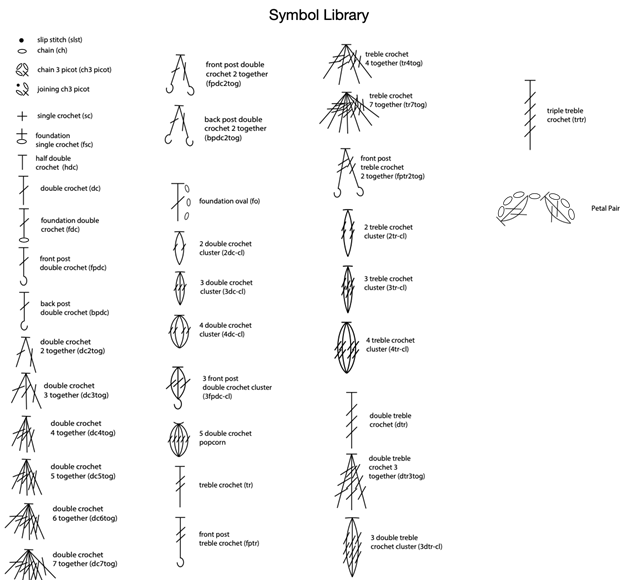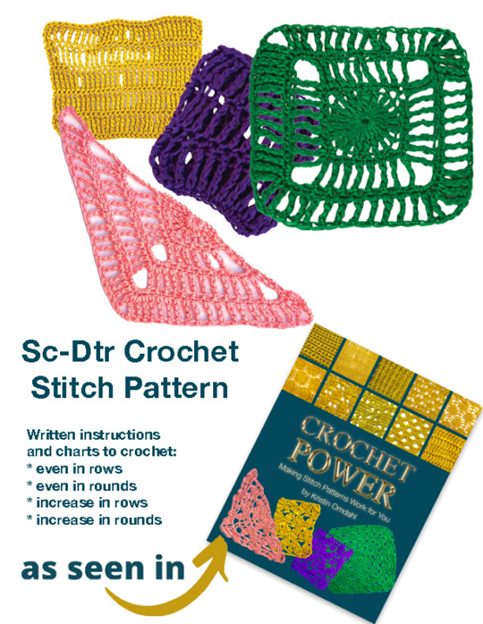
Get your own copy of Crochet Power: Making Stitch Patterns Work for You by Kristin Omdahl.
Use coupon code ILCENKJ10 for 10% off of either Crochet Power or the Crochet Power eBook through December 31, 2022.
You can also find Crochet Power on Amazon: https://www.amazon.com/Crochet-Power-Making-Patterns-Kristin/dp/B0B1C3K72L
How To Modify A Pattern
How To Use This Book
A pattern is like a recipe. The pattern gives you the fundamental concept of a project and
Get your own copy of Crochet Power: Making Stitch Patterns Work for You by Kristin Omdahl.
Use coupon code ILCENKJ10 for 10% off of either Crochet Power or the Crochet Power eBook through December 31, 2022.
You can also find Crochet Power on Amazon: https://www.amazon.com/Crochet-Power-Making-Patterns-Kristin/dp/B0B1C3K72L
How To Modify A Pattern
How To Use This Book
A pattern is like a recipe. The pattern gives you the fundamental concept of a project and you can follow along step by step to make the project exactly as written.
But if you strip down the components of a pattern, you have so many more options.
Gauge: Gauge is the measurement of the fabric that determines the size of what you are making. The goal is to match the gauge of a pattern to ensure proper size and fit. Intentionally manipulating gauge can alter size or density to create drastically different projects. Making a motif with thin yarn and a tiny hook could make a pair of earrings whereas crocheting the same motif in much thicker yarn could make a pillow cover or even a baby afghan. Sized garments made with a motif fabric can also be modified through gauge. For example, in a sample of nine motifs around, when the squares are 4 in (10cm), 4.25 in (10.8cm), 4.5 in (11.4cm), 4.75 in (12cm) or 5 in (12.7cm), the joined motif fabric garment will be 36 in (91.4cm), 38.25 in (97.2cm), 40.5 in (102.9cm), 42.75 in (108.6cm) or 45 in (114.3cm) bust. Even quarter inch increments make a big difference once it is multiplied.
Yarn weight: The chart on page 14 gives you a few examples to show you how you can broaden your pattern options when you double thinner yarns to create the texture and gauge of thicker yarns. Try tripling or quadrupling strands for even more possibilities. This is also a great way to explore colorwork, too.
Charts in Rows: If a pattern comes with a chart in rows, you can use it to create any other 2-dimensional project. Let’s say the pattern was for a scarf. You could use the same chart, with a different multiple of the stitch pattern, to make a wrap, a blanket, a pieced garment, or anything else that lies flat or can be sewn from flat pieces.
Charts in Rounds: If a pattern comes with a chart in rounds, you can use it to create any other 3-dimensional tubular project. Let’s say the pattern was for a hat, and the chart is for the walls of the hat. You could use the same chart, with a different multiple of the stitch pattern, to make a cowl, poncho, capelet, bag, sleeves, skirt, or anything else that is tubular.
Increases in Pattern: Whether a stitch pattern is grid or offset, adding 2 additional multiples for each additional repeat will give you a wedge shape. Whether you use this to create the double wedges for a triangular shawl, triple wedges for a half-hexagon shawl, quadruple wedges for a raglan yoke or square afghan or motif, there are endless possibilities when you add in-pattern increases to a stitch pattern. In the reference section you will see several examples and options for so many possibilities.
Adjusting the Height of Stitches:
With a few tricks, you can manipulate many stitch patterns for a variety of looks by simply swapping out shorter stitches for longer stitches or vice versa. For example, shorter stitches like single crochet are often dense and cozy. You can really affect the look, laciness and drape of the stitch pattern by simply elevating the height of your stitches from single crochet to half double and double crochet or longer.
Multiples and repeats: The majority of stitch patterns state up front how many stitches and rows are repeated for any size fabric. Most of the time a project worked in the round is a whole number multiple of the stitch pattern. And projects worked in rows often times will be that same multiple of the stitch pattern plus a few extra stitches.
For example, if the stitch pattern in rounds is a multiple of 8 stitches, in rows the multiple could be 8 + 3. This means you repeat the multiple of 8 as many times as necessary and then add 3 additional stitches.
Sizing Increments: Paying attention to the rate of increases in a sized garment pattern can give you an indication for adding additional sizes either smaller than or larger than the sizes in the given range.
Edging: Edgings and stitch patterns can be swapped out and used on other projects, too! An edging you love on an afghan could also be pretty on a shawl or a skirt hem.
There are so many varied ways to modify or re-use any pattern. Once you break down all the sections of a pattern, you will find a lot of information that can be extracted and used in other projects. There are so many ways to extract information from a pattern to use with other projects, too. The best way to demonstrate this is with actual examples.
In this book, each stitch pattern is interpreted four different ways for unlimited possibilities for exploration. Every stitch pattern is shown Even in Rows, Even in Rounds, Increase In Rows and
Increase In Rounds.
Each stitch pattern includes charts as well as written instructions for every adaptation of the pattern’s stitches along with repeating information for you to explore beyond the written words and charts.
Use the Even In Rows section to create any sized 2-dimensional fabric such as a scarf, place mat, afghan or any other flat fabric.
Use the Even In Rounds section to create any sized 3-dimensional tube fabric such as sleeves, cowls, skirts, hats, bags or other tubular fabric.
Use the Increase In Rows section to create any top down growing fabric with any number of repeats to create top down triangular shawls (2 repeats), top down half hexagon-shaped shawls (3 repeats) or top down capes or capelets (4 repeats).
Use the Increase In Rounds section to create any increasing fabric from the center out. Make a square motif, shawl or square baby blanket with 4 repeats; make a hexagon-shaped motif, shawl or afghan with 6 repeats. Or make an octagon-shaped motif, shawl or baby blanket with 8 repeats.
Here are some standard sizes for using any of the stitch patterns in this book for so many differently sized projects:
Working Even In Rows
Working “even in rows” is the term used for crocheting rows of stitches with the same number of stitches in each row. Generally there would be no increases or decreases. Working even in rows is the foundation for so many different kinds of projects. Once you know your gauge to create the width of your project, you can crochet any two dimensional square or rectangular project.
Here are some standard sizes for scarves, afghans, dishcloths, and more.
Bath:
Wash cloth: 10 in (25cm) x 10 in (25cm)
Blankets:
Lovey: 10 in (25cm) x 10 in (25cm)
Security: 14 in (36cm) x 18 in (46cm)
Stroller: 30 in (76cm) x 36 in (91cm)
Receiving: 36 in (91cm) x 36 in (91cm)
Toddler: 40 in (102cm) x 50 in (127cm)
Swaddle: 48 in (122cm) x 48 in (122cm)
Lap: 35 in (89cm) x 40 in (102cm)
Throw: 50 in (127cm) x 60 in (152cm)
Twin: 60 in (152cm) x 85 in (216cm)
Full: 90 in (229cm) x 90 in (229cm)
Queen: 96 in (244cm) x 94 in (239cm)
King: 108 in (274cm) x 90 in (229cm)
California King: 110 in (279cm) x 98 in
(249cm)
Kitchen:
Tea towel: 16 in (41cm) x 32 in (81cm)
Hand towel: 16 in (41cm) x 30 in (76cm)
Dish cloth: 8 in (20cm) x 8 in (20cm)
Pot scrubby: 4 in (10cm) x 4 in (10cm)
Rug: 18 in (46cm) x 36 in (91cm)
Floor runner: 18 in (46cm) x 60 in (152cm)
Table runner: 14 in (35cm) x 108 in (274cm)
Place mat: 12 in (30cm) x 18 in (46cm)
Coasters: 4 in (10cm) x 4 in (10cm)
Scarves:
Width:
3 in (8cm) to 5 in (13cm) for skinny scarf
5 in (13cm) to 8 in (20cm) for winter scarf
Length:
3 to 5 years: 36 in (91cm)
6 to 8 years: 44 in (112cm)
9 to 11 years: 50 in (127cm)
Preteen: 57 in (145cm)
Small Woman: 64 in (163cm)
Medium Woman: 68 in (173cm)
Large Woman: 69 in (175cm)
Small Man: 67 in (170cm)
Medium Man: 70 in (178cm)
Large Man: 75 in (191cm)
Stole/Wrap
Small: 24 in (61cm) wide x 50 in (127cm) long
Medium: 30 in (76cm) wide x 60 in (152cm) long
Large: 36 in (91cm) wide x 72 in (183cm) long
Working Even in Rounds
“Even in rounds” can be slightly different from crocheting even in rows, and more so when we get into more complicated stitch patterns. With single crochet, you have options. You can join your work at the end of each round with a slip stitch and begin the next round with a chain 1 before working each stitch around. Or you can work in a spiral and not join at the end of every round. The spiral method has invisible joins. Combined with circle motifs, working even in rounds makes easy hats (see size guide on pg 15) or you can make hats with just working even in rounds. For this style, you would begin at the brim and work up toward the crown. Once you fasten off leaving a long tail, weave the tail through all the stitches of final round with a yarn needle, and cinch tightly with the tail to form the crown. A longer height of the hat is required to accommodate the gathering of fabric for the cinched crown method. 1 – 2 in (2.5 – 5 cm) often works.
Cowls:
For a small cowl, add 2 in (5cm) to hat circumference x 8 in (20cm) long
For a medium cowl, add 4 in (10cm) to hat
circumference x 10 in (25cm) long
For a large cowl, add 6 in (15cm) to hat
circumference x 12 in (30cm) long
See hat sizes on pg 15.
Working Increase in Rows
Top down triangular shapes (2 repeats) are a perfect beginning for a shawl. You simply continue in the established pattern until you reach the desired length. They are also the fundamentals for top down raglan shaping of
capes, cardigans and pullovers. If you are joining motifs together, triangular motifs add straight edges to square motifs when they are joined on the diagonal. Keep in mind that this is using this section for TWO repeats. You can also use the increase in rows section to create a half hexagon (3 repeats).
Shawl sizes:
Kerchief: 36 in (91cm) wide x 18 in (46cm) long
Shawlette: 24 in (61cm) – 30 in (76cm) wide
x 48 in (122cm) to 60 in (152cm) wide
Full sized shawl: 36 in (91cm) – 40 in (102cm) long x 72 in (183cm) to 80 in
(203cm) wide
Working Increase In Rounds
Square motifs in the round are classically known as the building blocks for motif projects whether you join them as you go with crochet stitches or seams at the end. But singularly, there are many other applications for a square motif. Continue in pattern to make a singular square as large as you can possibly imagine! And keep in mind that this is using this section for FOUR repeats. You can use an “increase in rounds” section to create hexagons (6 repeats) or octagons (8 repeats) as well.
Earring: 2 in (5cm) – 3 in (8cm) wide
Coaster: 4 in (10cm) wide
Dishcloth: 9 in (23cm) wide
Bag: 12 in (30cm) – 16 in (41cm) wide
Rug:
Small: 4 ft (122cm) wide
Medium: 6 ft (183cm) wide
Large: 8 ft (244cm) wide
Square Shawls:
Small: 48 in (122cm) square
Medium: 60 in (152cm) square
Large: 72 in (183cm) square
SINGLE-DOUBLE TREBLE CROCHET ROWS: EVEN IN ROWS
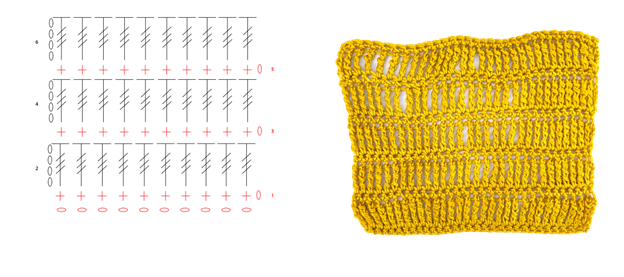
Even in Rows
Multiple: any number of stitches
Row 1: Ch11, sc in 2nd ch from hook and each ch across, turn. — 10 scs
Row 2: Ch4 (does not count as dtr), 1dtr in ea st across, turn. — 10 dtrs
Row 3: Ch1, sc in ea st across, turn. — 10 scs
Rep rows 2 – 3 for pattern repeat.
SINGLE-DOUBLE TREBLE CROCHET ROWS: EVEN IN ROUNDS
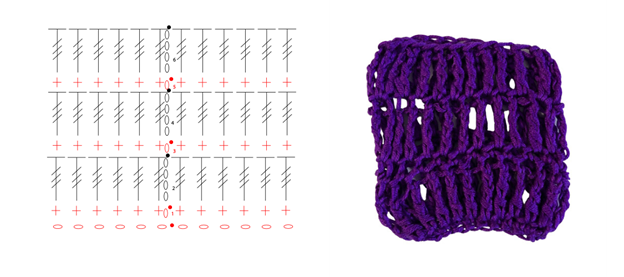
Even in Rounds
Multiple: any number of stitches
Round 1: Ch24, slst to first ch to form ring, being careful not to twist chain. Ch1, sc in ea ch around, slst to top of first sc at beg of round to join. — 24 scs
Round 2: Ch4 (does not count as dtr), 1dtr in ea sc around, slst to top of first dtr at beg of round to join. — 24 dtrs
Round 3: Ch1, sc in ea dtr around, slst to top of first sc at beg of round to join. — 24 scs
Rep rounds 2 – 3 for desired length.
SINGLE-DOUBLE TREBLE CROCHET: INCREASE IN ROWS
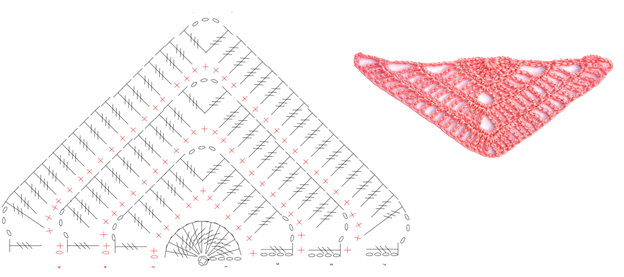
Increase in Rows
Two repeats for
top down triangle shape
Ch4, slst to 4th ch from hook to form ring.
Row 1: Ch4 (does not count as a st), 11dtr in ring, turn. — 11 dtr
Row 2: Ch1, 2sc in first st, 1sc in ea of next 4 dtr, 3sc in next dtr, 1sc in ea of next 4 dtr, 2sc in last dtr, turn. — 13 scs
Row 3: Ch4 (does not count as a st), dtr in first st, ch3, 1dtr in ea of next 5 scs, (dtr, ch3, dtr) in next sc, 1dtr in ea of next 5 scs, ch3, 1dtr in last sc, turn. — 14 dtr
Row 4: Ch1, 1sc in first dtr, 3sc in ch3 sp, 1sc in ea of next 6 dtr, 5sc in ch3 sp, 1sc in ea of next 6 dtr, 3sc in next ch3 sp, 1sc in last dtr, turn. — 25 scs
Row 5: Ch4 (coes not count as a st), dtr in first st, ch3, 1dtr in ea of next 11 scs, (dtr, ch3, dtr) in next sc), 1dtr in ea of next 11 scs, ch3, 1dtr in last sc, turn. — 26 dtr
Row 6: Ch1, sc in first dtr, 3sc in ch3 sp, 1sc in ea of next 12 dtr, 5sc in ch3 sp, 1sc in ea of next 12 dtr, 3sc in next ch3 sp, 1sc in last dtr, turn. — 37 scs
Row 7: Ch4 (does not count as a st), dtr in first st, ch3, 1dtr in ea of next 17 scs, (dtr, ch3, dtr) in next sc), 1dtr in ea of next 17 scs, ch3, 1dtr in last sc, turn. — 38 dtr
Rep rows 6 and 7 for desired length.
Note: Each additional even numbered row increases by 12 scs and each odd numbered row increases by 12 dtr.
SINGLE-DOUBLE TREBLE CROCHET: INCREASE IN ROUNDS
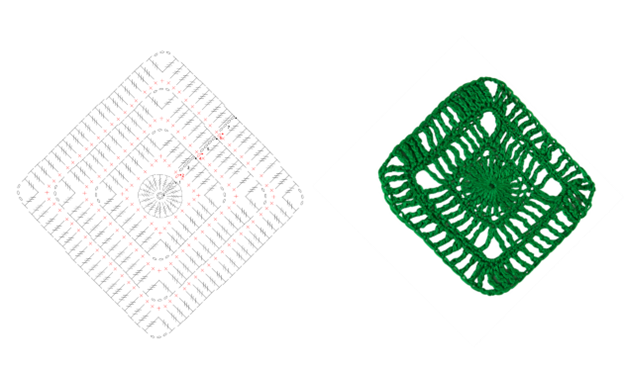
Increase in Rounds
Four repeats
for square shape
Ch4, slst to 5th ch from hook to form ring.
Round 1: Ch4 (does not count as a st), 20 dtr in ring, slst to top of first dtr at beg of round to join. — 20 dtr
Round 2: Ch1, *1sc in ea of next 2 dtr, 3sc in next dtr, 1sc in ea of next 2 dtr. Rep from * around, slst to top of first sc at beg of round to join. — 28 scs
Round 3: Ch4 (does not count as dtr), *1dtr in ea of next 3 scs, (dtr, ch3, dtr) in next sc, 1dtr in ea of next 3 scs. Rep from * around, slst to top of first dtr at beg of round to join. — 32 dtr
Round 4: Ch1, *1sc in ea of next 4 dtr, 5sc in next ch3 sp, 1sc in ea of next 4 dtr. Rep from * around, slst to top of first sc at beg of round to join. — 52 scs
Round 5: Ch4 (does not count as dtr), *1dtr in ea of next 6 scs, (dtr, ch3, dtr) in next sc), 1dtr in ea of next 6 scs. Rep from * around, slst to top of first dtr at beg of round to join. — 56 dtr
Round 6: Ch1, *1sc in ea of next 7 dtr, 5sc in next ch3 sp, 1sc in ea of next 7 dtr. Rep from * around, slst to top of first sc at beg of round to join. — 76 scs
Round 7: Ch4 (does not count as dtr), *1dtr in ea of next 9 scs, (dtr, ch3, dtr) in next sc), 1dtr in ea of next 9 scs. Rep from * around, slst to top of first dtr at beg of round to join. — 80 dtr
Rep rounds 6 – 7 for desired length.
Note: Each additional even numbered round increases by 24 scs and each odd numbered round increases by 24 dtrs.
CROCHET GLOSSARY
2Dc-Cluster (2dc-cl): Yarn over, insert hook in next specified stitch, yarn over and pull up a loop. Yarn over, pull through 2 loops on hook. Yarn over, insert hook in same stitch, yarn over and pull up a loop. Yarn over and pull through 2 loops on hook (3 loops on hook). Yarn over, pull through all 3 loops on hook.
2Tr-Cluster (2tr-cl): Yarn over twice, insert hook in next specified stitch, yarn over and pull up a loop. (Yarn over, pull through 2 loops on hook)x2. Yarn over twice, insert hook in same stitch, yarn over and pull up a loop. (Yarn over and pull through 2 loops on hook)x2, (3 loops on hook). Yarn over, pull through all 3 loops on hook.
3Dc-Cluster (3dc-cl): Yarn over, insert hook in next specified stitch, yarn over and pull up a loop. Yarn over, pull through 2 loops on hook. *Yarn over, insert hook in same stitch, yarn over and pull up a loop. Yarn over and pull through 2 loops on hook (3 loops on hook). Rep from * once more, (4 loops on hook). Yarn over, pull through all 4 loops on hook.
3Dtr-Cluster (3dtr-cl): Yarn over 3 times, insert hook in next specified stitch, yarn over and pull up a loop. (Yarn over, pull through 2 loops on hook)x3. *Yarn over 3 times, insert hook in same stitch, yarn over and pull up a loop. (Yarn over and pull through 2 loops on hook)x3, (3 loops on hook). Rep from * once more, (4 loops on hook). Yarn over, pull through all 4 loops on hook.
3 Front Post Double Crochet Cluster (3fpdc-cl): Yarn over, wrap the yarn around the post (or stem) of the specified stitch from front to back to front, yarn over and pull up a loop. Yarn over and pull through 2 loops on hook. *Yarn over, wrap the yarn around the post of the same stitch from front to back to front, yarn over and pull up a loop. Yarn over and pull through 2 loops on hook. Rep from * once more, (4 loops on hook). Yarn over and pull through all 4 loops on hook.
3Tr-Cluster (3tr-cl): Yarn over twice, insert hook in next specified stitch, yarn over and pull up a loop. (Yarn over, pull through 2 loops on hook)x2. *Yarn over twice, insert hook in same stitch, yarn over and pull up a loop. (Yarn over and pull through 2 loops on hook)x2, (3 loops on hook). Rep from * once more, (4 loops on hook). Yarn over, pull through all 4 loops on hook.
4Dc-Cluster (4dc-cl): Yarn over 3 times, insert hook in next specified stitch, yarn over and pull up a loop. (Yarn over, pull through 2 loops on hook)x3. *Yarn over 3 times, insert hook in same stitch, yarn over and pull up a loop. (Yarn over and pull through 2 loops on hook)x3, (3 loops on hook). Rep from * twice more, (5 loops on hook). Yarn over, pull through all 5 loops on hook.
4Tr-Cluster (4tr-cl): Yarn over twice, insert hook in next specified stitch, yarn over and pull up a loop. (Yarn over, pull through 2 loops on hook)x2. *Yarn over twice, insert hook in same stitch, yarn over and pull up a loop. (Yarn over and pull through 2 loops on hook)x2, (3 loops on hook). Rep from * twice more, (5 loops on hook). Yarn over, pull through all 5 loops on hook.
5 Dc Popcorn: Work 5dc in same sp, drop loop from hook, insert hook from front to back in the top of the first dc of group, pick up dropped loop and pull through.
Back Post Double Crochet (bpdc): Yarn over hook, wrap the yarn around the post (or stem) of the specified stitch from back to front to back, yarn over and pull up a loop. (Yarn over, pull through 2 loops on hook)x2.
Back Post Double Crochet 2 Together (bpdc2tog): *Yarn over hook, wrap the yarn around the post or stem of the speciified stitch from back to front to back, yarn over and pull up a loop (3 loops on hook) Yarn over, pull through the first two loops only. Rep from * once more in next st. Yarn over, pull through all three loops on the hook.
Chain (ch): Wrap the yarn over the hook in a clockwise direction. Draw the yarn through to form a new loop without tightening the previous one.
Chain 3 Picot (ch3 picot): Ch3, sc in 3rd ch from hook.
Double crochet (dc): Wrap the yarn over the hook and insert the hook into the work (or specified chain from hook), wrap the yarn over the hook, draw through the work only and wrap the yarn again. Draw through the first two loops only and wrap the yarn around the hook again. Draw through the last two loops on the hook.
Double crochet 2 together (dc2tog): Yarn over, insert hook into stitch and pull up a loop. Yarn over, pull through 2 loops on hook. Yarn over, insert hook into next stitch and pull up a loop. Yarn over, pull through 2 loops on hook. Yarn over, pull through all 3 loops on hook.
Double crochet 3 together (dc3tog): Yarn over, insert hook into stitch and pull up a loop. Yarn over, pull through 2 loops on hook. *Yarn over, insert hook into next stitch and pull up a loop. Yarn over, pull through 2 loops on hook. Rep from * once more. Yarn over, pull through all 4 loops on hook.
Double Crochet 4 together (dc4tog): Yarn over, insert hook into stitch and pull up a loop. Yarn over, pull through 2 loops on hook. *Yarn over, insert hook into next stitch and pull up a loop. Yarn over, pull through 2 loops on hook. Rep from * twice more. Yarn over, pull through all 5 loops on hook.
Double crochet 5 together (dc5tog): Yarn over, insert hook into stitch and pull up a loop. Yarn over, pull through 2 loops on hook. *Yarn over, insert hook into next stitch and pull up a loop. Yarn over, pull through 2 loops on hook. Rep from * 3 more times. Yarn over, pull through all 6 loops on hook.
Double crochet 6 together (dc6tog): Yarn over, insert hook into stitch and pull up a loop. Yarn over, pull through 2 loops on hook. *Yarn over, insert hook into next stitch and pull up a loop. Yarn over, pull through 2 loops on hook. Rep from * 4 more times. Yarn over, pull through all 7 loops on hook.
Double crochet 7 together (dc7tog): Yarn over, insert hook into stitch and pull up a loop. Yarn over, pull through 2 loops on hook. *Yarn over, insert hook into next stitch and pull up a loop. Yarn over, pull through 2 loops on hook. Rep from * 5 more times. Yarn over, pull through all 8 loops on hook.
Double treble crochet (dtr): Yarn over hook 3 times, insert hook into stitch indicated and pull up a loop, (yarn over and draw through 2 loops on hook)x4.
Double treble crochet 3 together (dtr3tog): Yarn over hook 3 times, insert hook into stitch indicated and pull up a loop, (yarn over and draw through 2 loops on hook)x3 (2 loops on hook), *yarn over hook 3 times, insert hook into next stitch indicated and pull up a loop, (yarn over and draw through 2 loops on hook)x3 (3 loops on hook). Rep from * once more, (4 loops on hook). Yarn over and draw through all 4 loops on hook.
Foundation oval (ch3, dc) (fo): *Ch3, dc in third ch from hook. Rep from * for desired length.
Foundation single crochet (fsc): Ch2, insert hook in 2nd ch from hook, yarn over hook and pull up a loop (2 loops on hook), yarn over hook, pull yarn through first loop on hook, yarn over hook and draw through 2 loops on hook. — 1 fsc made.
*Insert hook under 2 loops of ch made at base of previous stitch, yarn over hook and draw up a loop (2 loops on hook), yarn over hook and draw through first loop on hook, yarn over hook and draw through 2 loops on hook. Rep from * for length of foundation.
Front post double crochet (fpdc): Yarn over hook, wrap the yarn around the post (or stem) of the specified stitch from front to back to front, yarn over and pull up a loop (3 loops on hook) Yarn over, pull through the first two loops only. Yarn over, pull through the last two loops on the hook.
Front post double crochet 2 together (fpdc2tog): *Yarn over hook, wrap the yarn around the post (or stem) of the specified stitch from front to back to front, yarn over and pull up a loop (3 loops on hook) Yarn over, pull through the first two loops only. Rep from * once more in next st. Yarn over, pull through all three loops on the hook.
Front Post Treble Crochet (fptr): Yarn over twice, wrap the yarn around the post of the specified stitch from front to back to front, yarn over and pull up a loop. (Yarn over, pull through 2 loops)x3.
Half Double Crochet (hdc): Yarn over hook, insert hook in specified stitch, yarn over and pull up a loop. Yarn over and pull through all 3 loops on hook.
Joining Ch3 Picot: Ch1, slst to adjacent picot, ch1, sc in 3rd ch from hook.
Make Flower: Turn 90 degrees counterclockwise and working along side of post of dc just worked, work (slst, ch2, 3dc, ch2, slst) around post of dc, turn 90 degrees counterclockwise and working in ch2 sp on prev row, work (slst, ch2, 3dc, ch2, slst) in ch2 sp, turn 90 degrees counterclockwise and working in side of post of next dc, work (slst, ch2, 3dc, ch2, slst) around post of dc, turn work 90 degrees counterclockwise and working in ch2 sp on current row, work (slst, ch2, 3dc, ch2, slst) in ch3 sp.
Beginning Petal Pair (bpp): Ch10, 2dc-cl (see above) in 4th ch from hook (petal made), ch4, 2dc-cl in 4th ch from hook, slst in between next petal pair of last row.
Petal Pair (pp): (Ch4, 2dc-cl in 4th ch from hook)x2.
Single crochet (sc): Insert the hook into the work (or specified chain from hook), wrap the yarn over the hook and pull the yarn through the work only. Wrap the yarn around the hook again and pull it through both loops.
Slip stitch (slst): Insert hook into specified stitch. Wrap the yarn over the hook. Draw the yarn through the stitch and through the loop on the hook.
Beginning Teardrop Stitch (beg teardrop): Ch4, 3-tr cluster in same sp, ch3.
Teardrop Stitch (teardrop): Yox5, insert hook in next st, yo, pull up a loop, (yarn over, pull through 2 loops on hook)x2, *yox2, insert hook in next st, pull up a loop, (yo, pull through 2 loops on hook)x2; rep from * 3 times in same st, yo, pull through all 5 loops on hook, (yo, pull through 2 loops on hook)x3.
Treble Crochet (tr): Yarn over twice, insert hook in next specified stitch and pull up a loop, (yarn over, pull through 2 loops on hook)x3.
Treble Crochet 4 Together (tr4tog): *Yarn over twice, insert hook in next specified stitch, (yarn over, pull through 2 loops on hook)x2. Rep from * three more times. Yo, pull through all 5 loops on hook.
Treble Crochet 7 Together (tr7tog): *Yarn over twice, insert hook in next specified stitch, (yarn over, pull through 2 loops on hook)x2. Rep from * six more times. Yo, pull through all 8 loops on hook.
Triple Treble Crochet (trtr): Yarn over four times, insert hook in next specified stitch
and pull up a loop, (yarn over, pull through 2 loops on hook)x5.
